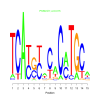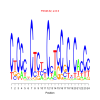Module 177 Residual: 0.22
| Title | Model version | Residual | Score |
|---|---|---|---|
| bicluster_0177 | v02 | 0.22 | -12.10 |
Displaying 1 - 21 of 21
| Cre01.g016400.t1.1 | Cre01.g049400.t1.2 HIT-type Zinc finger family protein |
| Cre02.g092150.t1.2 Protein kinase family protein with leucine-rich repeat domain | Cre02.g103050.t1.2 |
| Cre02.g147050.t1.2 | Cre03.g190850.t1.2 ATP-dependent caseinolytic (Clp) protease/crotonase family protein |
| Cre03.g194150.t1.1 Fcf2 pre-rRNA processing protein | Cre05.g232002.t2.1 acyl-CoA oxidase 2 |
| Cre07.g315400.t1.1 P-loop containing nucleoside triphosphate hydrolases superfamily protein | Cre07.g335900.t1.2 carboxypeptidase D, putative |
| Cre09.g400590.t1.1 | Cre09.g400627.t1.1 Polyketide cyclase / dehydrase and lipid transport protein |
| Cre09.g401663.t1.1 | Cre10.g435650.t1.1 Major facilitator superfamily protein |
| Cre10.g467100.t1.1 nuclear assembly factor 1 | Cre12.g484350.t1.1 homolog of yeast sucrose nonfermenting 4 |
| Cre12.g513701.t1.2 hydrolases, acting on acid anhydrides, in phosphorus-containing anhydrides;ATP-dependent helicases;nucleic acid binding;ATP binding;RNA binding;helicases | Cre12.g561500.t1.2 |
| Cre14.g624201.t1.1 chloroplastic drought-induced stress protein of 32 kD | Cre17.g699100.t1.1 Patatin-like phospholipase family protein |
| Cre17.g716400.t1.2 Zinc finger protein 622 |
|
e.value: 0.015 Motif Bicluster: Width: 15 Number of Sites: 1 Consensus: TCAtgcacaCaTGCa |
motif_0177_2Submitted by Anonymous (not verified) on Wed, 05/20/2015 - 14:16e.value: 6.9 Motif Bicluster: Width: 24 Number of Sites: 1 Consensus: CtCCcnCtctcCctcCgCnCacCc |
Displaying 1 - 1 of 1
| Interaction | Weight | |
|---|---|---|
Displaying 1 - 1 of 1
| GO Terms | Descriptions |
|---|---|
| Not available |




Comments